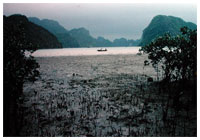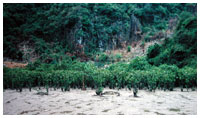home > research > population genetic structure of natural mangrove forests of Avicennia sp. in vietnam: the recovery of genetic diversity 3 decades after agent orange
Population genetic structure of natural mangrove forests of Avicennia sp. in Vietnam: the recovery of genetic diversity 3 decades after Agent Orange
 Mangrove forests, together with seagrasses, are major keystone ecosystem structuring species along the coastlines of the world’s tropical regions, and in addition to their ecological role their ecosystem services have high economic value, particularly as nurseries for commercially important species. However, there has been widespread mangrove reduction throughout SE Asian coastlines, associated with human activities. The aim of this research theme is the assessment of population genetic structure in disturbed mangrove forests in SE Asia. Avicennia spp were chosen as model species because these are not artificially planted and thus reflect ecosystem history.
Mangrove forests, together with seagrasses, are major keystone ecosystem structuring species along the coastlines of the world’s tropical regions, and in addition to their ecological role their ecosystem services have high economic value, particularly as nurseries for commercially important species. However, there has been widespread mangrove reduction throughout SE Asian coastlines, associated with human activities. The aim of this research theme is the assessment of population genetic structure in disturbed mangrove forests in SE Asia. Avicennia spp were chosen as model species because these are not artificially planted and thus reflect ecosystem history.
 The destruction of the Mekong Delta mangrove forests by Agent Orange is possibly the largest human disturbance event experienced by any ecosystem. One objective of this research theme is the evaluation of the genetic composition of the mangrove forest recruited following the Vietnam war.
The destruction of the Mekong Delta mangrove forests by Agent Orange is possibly the largest human disturbance event experienced by any ecosystem. One objective of this research theme is the evaluation of the genetic composition of the mangrove forest recruited following the Vietnam war.Another objective is to assess whether populations of Avicennia marina at its NW distributional margin in Northern Vietnam, exhibit lower genetic variability, higher differentiation, and higher inbreeding than core populations.
On top, Avicennia marina aerial roots, Halong Bay,Vietnam;
Above, Avicennia marina patch, Halong Bay,Vietnam (photos by E Serrao)
more photos


